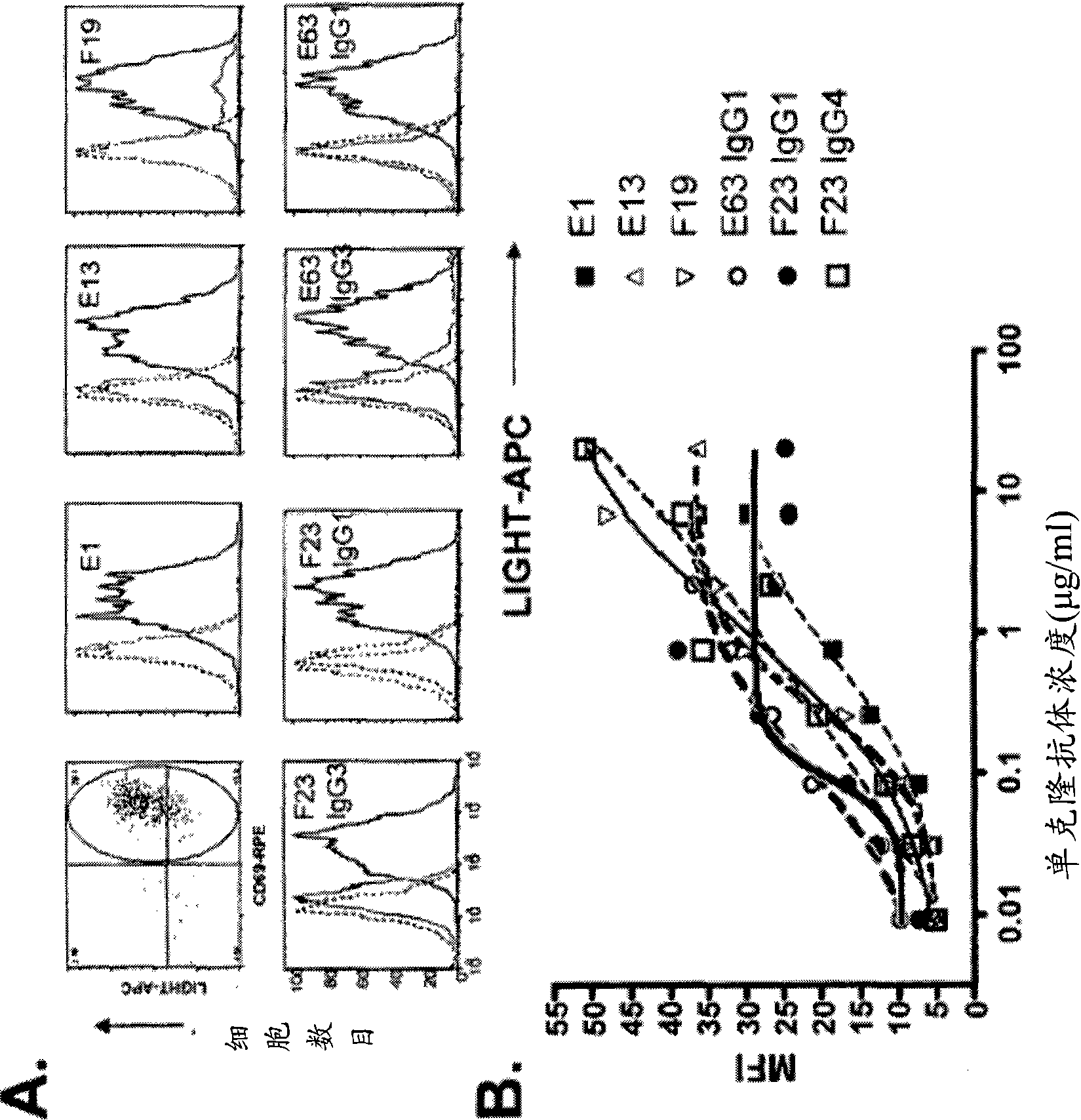Antagonistic human light-specific human monoclonal antibodies
An antibody and species-specific technology, applied in the field of antagonistic antibodies to treat hLIGHT-mediated diseases
- Summary
- Abstract
- Description
- Claims
- Application Information
AI Technical Summary
Problems solved by technology
Method used
Image
Examples
preparation example Construction
[0370] For long-term production of high-yield recombinant proteins, stable expression is preferred. For example, cell lines that stably express antibody molecules can be engineered. Host cells can be transformed with DNA controlled by appropriate expression control elements (e.g., promoters, enhancers, sequences, transcription terminators, polyadenylation sites, etc.) Vector transformation. After the introduction of exogenous DNA, engineered cells are cultured in enriched medium for 1-2 days, and then transferred to selective medium. A selectable marker in the recombinant plasmid makes it resistant to the selection factor and allows the cells to stably integrate the plasmid into their chromosomes and grow to produce foci that can be subsequently cloned and expanded into cell lines. This method can be used to engineer cell lines that express antibody molecules. Such engineered cell lines are particularly useful for screening and evaluating compositions that interact directly...
Embodiment 1
[0380] Example 1 Preparation of human anti-hLIGHT antibody
[0381] In this example, transchromosomal mice (KM mice) immunized with soluble recombinant hLIGHT are described. TM ) (WO 02 / 43478; WO 02 / 092812; Ishida and Lonberg, IBC's 11 th Antibody Engineering Meeting. Abstract (2000); and Kataoka, S. IBCs 13 th Antibody Engineering Meeting. Abstract (2002)) prepared human anti-hLIGHT monoclonal antibody. The antibodies of the present invention can specifically stain hLIGHT stably transfected cell lines (EL4-hLIGHT and HEK293-hLIGHT), but not their parental cell lines. Likewise, they can bind hLIGHT (Ware et al., 1986 Lymphokine Res 5313-24) endogenously expressed on the surface of human T cell hybridoma (II-23.D7) after activation. These data show that the antibody binds hLIGHT immunospecifically. The isolated antibodies recognized one or two epitopes on hLIGHT as determined by cross-blocking assays as described below. Furthermore, the antibodies were able to simultaneous...
Embodiment 2
[0657] Example 2 Identification of commercially available mouse anti-human monoclonal antibodies
[0658] Antibody cross-blocking. Cross-blocking assays were performed as described in Example 1 and using mouse anti-hLIGHT monoclonal antibodies from R&D Systems ("R&D mouse mAb") and Abnova ("Abnova mouse mAb") and the Human anti-hLIGHT monoclonal antibody to assess the hLIGHT epitope to which the antibody binds. The results are shown in Figure 11 .
[0659] The results showed that the R&D mouse mAb binds to the same epitope as human E1, E13, and E63 monoclonal antibodies ("human E antibodies"), and binds to the same epitope as human F19 and F23 monoclonal antibodies ("human F antibodies") bit. Thus, unlike the human anti-hLIGHT E&F monoclonal antibodies identified in Example 1 that immunospecifically bind only one of two different epitopes, this R&D mouse mAb binds both sets of hLIGHT epitopes simultaneously. That is, the human E antibody and the human F antibody identif...
PUM
 Login to View More
Login to View More Abstract
Description
Claims
Application Information
 Login to View More
Login to View More - R&D
- Intellectual Property
- Life Sciences
- Materials
- Tech Scout
- Unparalleled Data Quality
- Higher Quality Content
- 60% Fewer Hallucinations
Browse by: Latest US Patents, China's latest patents, Technical Efficacy Thesaurus, Application Domain, Technology Topic, Popular Technical Reports.
© 2025 PatSnap. All rights reserved.Legal|Privacy policy|Modern Slavery Act Transparency Statement|Sitemap|About US| Contact US: help@patsnap.com



